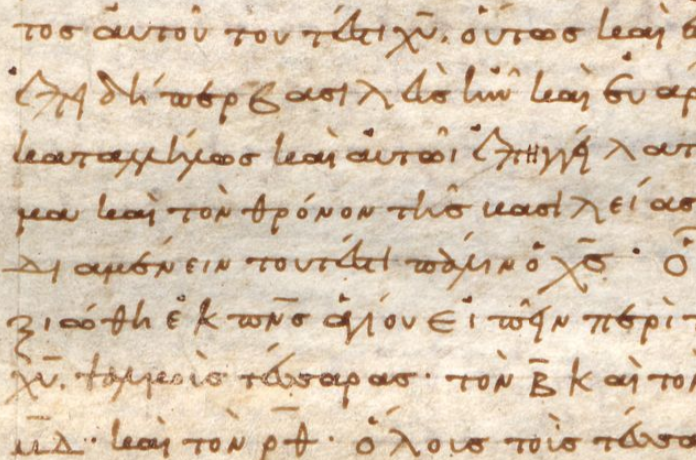Introduction
The goal is a transcription of all the Expositiones in Psalmos (Ps 1–50) from their leading catena manuscripts which will be presented online. Each leading manuscript has a file of its own. For a selected number of manuscripts, these files contain also an overview of all the other fragments (content list). The psalm portion (lemma) to which each fragment refers in the manuscript and the presence (or absence) of an author attribution are documented. If one fragment is linked to a precise word of the psalm by means of a linking sign or letter, this word is also documented.
In catena manuscripts, lemmata and explanations are connected in different ways. The simplest way is to make the explanation follow the lemma (full-page catena). The marginal catena format can only function through the use of linking systems by means of counting letters or signs. These systems are sometimes very sofisticated. Sometimes these connections are faulty, especially in marginal catenae. The scribe may omit to create a linking or create a wrong one or fail to complete the linking by neglecting to place the connecting symbol either at the explanation or the biblical text. These phenomena are reported as far as possible.
Macrostructure
The macrostructure records the genres of the texts and their position in a manuscript.
- At the beginning of a psalm:
- Hypopsalmos
- A short invocation, e.g. "Alleluja", which is usually written in the top margin of a manuscript as a heading.
- Hypothesis
- A summary of the contents of a psalm, a short introduction or a note concerning the setting of a psalm. Various patristic authors wrote such hypotheseis in their commentaries on the Psalms: Eusebius of Caesarea, (Ps.)-Athanasius, Hesychius of Jerusalem, etc.
- Perioche
- A short sketch of the contents of a psalm. This genre goes back to Eusebius of Caesarea and his commentary.
- The bibletext:
- The psalmtext
- For the numbering we follow the edition of the Septuagint of Rahlfs. The tituli are counted as verse 1.
- Hexaplaric variants
- Some manuscripts contain hexaplaric variants in the margins and distinguish between Aquila, Symmachus, Theodotion, Quinta, and Sexta.
- Glosse
- A word is explained or clarified by synonyms.
- The commentary:
- Commentaryfragments
- The commentaryfragments are – if possible – classified as quotation, adapted or abbreviated quotation, paraphrase or abbreviated paraphrase. The quotation category means that a fragment attested in a catena manuscript matches an edition not based on this particular catena.
- Quotations
- Quotations are graphically marked in the transcription and the source is noted.
Microstructure
- Abbreviations with expansion:
- Nomina sacra
Diplomatic Normalized χυ (Χριστοῦ) Χριστοῦ θς (θεός) θεός - Suspension
Diplomatic Normalized φη(σὶν) φησὶν αυτ(οῦ) αὐτοῦ - Tachygraphy
Diplomatic Normalized τ(ῶν) τῶν (καὶ) καὶ κεκτημέν(ους) κεκτημένους
- Nomina sacra
- Accent, spiritus, errors (itazism, vocalquantity): Corrections according to the grammatical norm are only made when the manuscript is not consistent in itself.
Diplomatic Normalized σφὰς (σφᾶς) σφᾶς Ὡριγένους (Ὠριγένους) Ὠριγένους ηὐδόκισας (ηὐδόκησας) ηὐδόκησας στρομνήν (στρωμνήν) στρωμνήν - Coronis, particle (encliticon / procliticon), contracted words, numbers: Regularization according to the grammatical norm or according to the predominant habit of the manuscript.
Diplomatic Normalized κακείν(ων) κἀκείνων ἠ (ἢ) ἢ παρέλλησι (παρ᾿ ἕλλησι) παρ᾿ ἕλλησι καθημῶν (καθ’ ἡμῶν) καθ’ ἡμῶν - Punctuation: For the transcription of the punctuation mainly four different signs are used: Mese (point in the middle), Hypostygme (point on the bottom line), Teleia (point above) and bullet for emphasized endpoints.
- Iota subscriptum / Iota adscriptum:
Diplomatic Normalized τῶ νόμω (τῷ νόμῷ) τῷ νόμῷ τῶι νόμωι (τῷ νόμῳ) τῷ νόμῳ - Textcritics:
- Ambivalent signs
Diplomatic Normalized κατὰ κατὰ - Not readable signs
Diplomatic Normalized [...] [...] - Restored signs (by context, parallel tradition or edition)
Diplomatic Normalized [κατὰ] [κατὰ] - Uncertain restored signs
Diplomatic Normalized [κατὰ (?)] [κατὰ (?)] - Space left empty by the scribe (fenestra)
Diplomatic Normalized [4 character(s) left intentionally blank] - Deleted but legible signs
Diplomatic Normalized ⟦κατὰ⟧ - Deleted, not legible signs
Diplomatic Normalized ⟦...⟧ - Signs added by ancient hand
Diplomatic Normalized κατ\ὰ/ κατὰ κατ/ὰ\ κατὰ - Signs corrected by ancient hand, original not legible
Diplomatic Normalized κατ«ὰ» κατὰ - Signs corrected by the scribe
Diplomatic Normalized κατὰ [* καθ᾿ S κατὰ] κατὰ - Signs corrected by a corrector
Diplomatic Normalized κατὰ [* καθ᾿ C1 κατὰ] κατὰ - Signs corrected by an unidentified corrector
Diplomatic Normalized κατὰ [* καθ᾿ corr κατὰ] κατὰ - Signs added by ancient hand
Diplomatic Normalized 《κατὰ》 (add. C1) κατὰ - Signs added by the editor
Diplomatic Normalized κατ〈ὰ〉 κατ〈ὰ〉 - Signs deleted by the editor
Diplomatic Normalized κα{ι}τὰ κατὰ - Lacuna
Diplomatic Normalized [4 character(s) missing] [4 character(s) missing] [1 line(s) missing] [1 line(s) missing] [1 page(s) missing] [1 page(s) missing] - Textcorruption
Diplomatic Normalized κατὰ (sic) κατὰ (sic)
- Ambivalent signs


